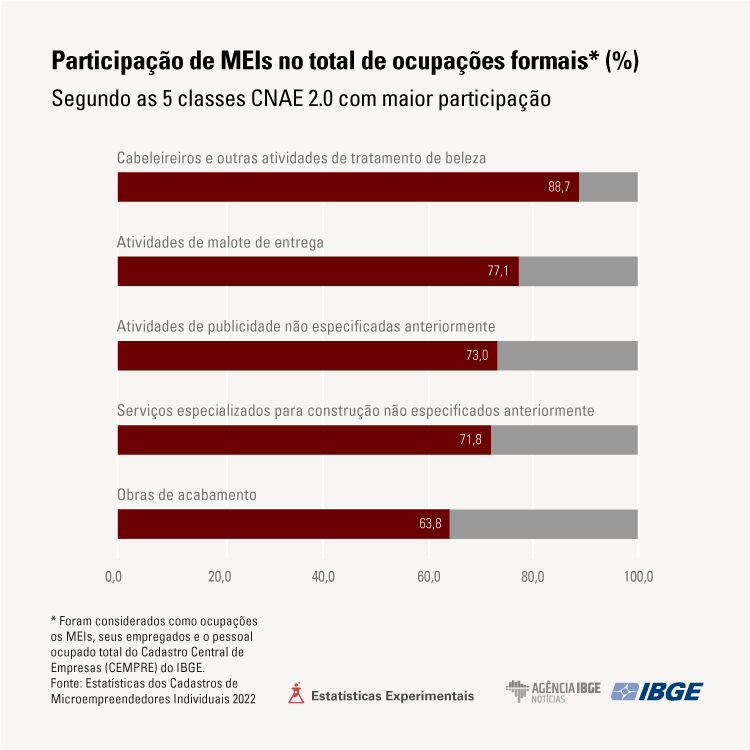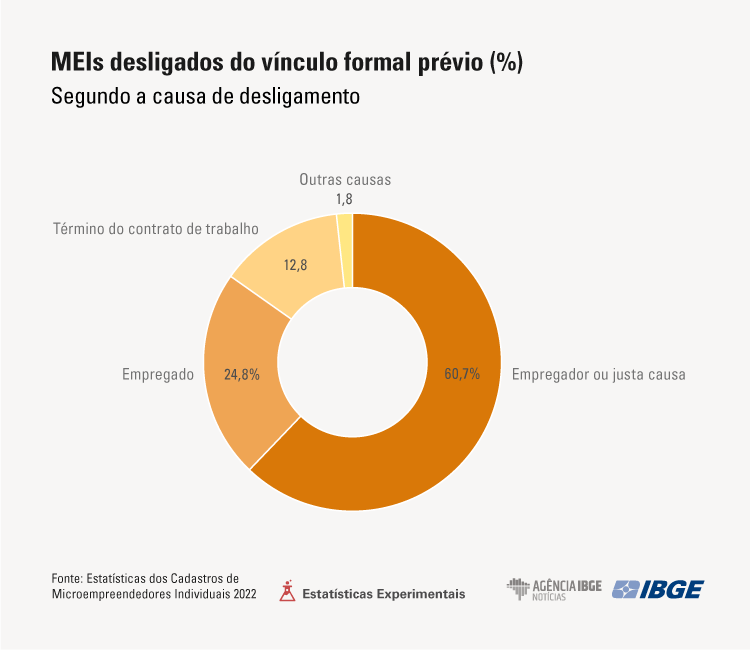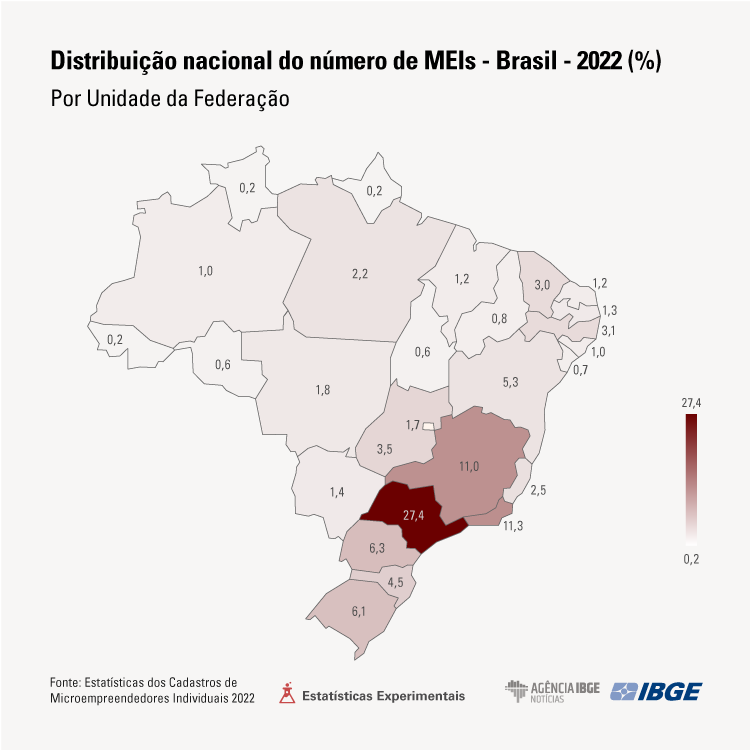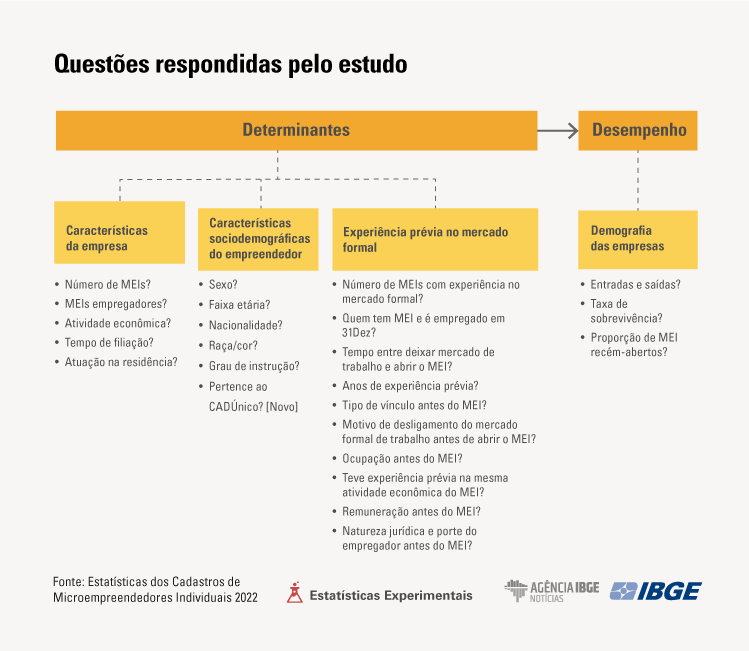Experimental Statistics
In 2022, Brazil had 14.6 million individual microentrepreneurs
August 21, 2024 10h00 AM | Last Updated: August 23, 2024 01h00 AM
Highlights
- In 2022, there were 14.6 million individual entrepreneurs (MEIs) in Brazil. This figure corresponds to 18.8% of the total number of persons with a formal job. That representes an increase of 1.5 million MEIs from 2021;
- Between 2021 and 2022, it was observed that the number of MEI employers (with one employee) increased from 104.1 thousand to 133.8 thousand;
- About 69.4% of the active MEIs in 2022 had registered in the previous five years. Only those registered in 2022 (2.6 million) represent approximately 1/5 of all the MEIs;
- As for the economic activities, about half of the MEIs (51.5%) were in the Services sector in 2022;
- The activity Hairdressing and other beauty treatment stood out in 2022, and accounted for 9.0% of the total MEIs (1.3 million) and a bigger participation of individual microentrepreneurs in occupations of this activity, with 88.7%;
- Of the total 14.6 million MEIs in 2022, 4.1 million, that is, 28.4%, were part of CADÚnico. And 2.1 million were listed in the Bolsa-Família Program (PBF), a total of 49.8% of the entrepreneurs in CADÚnico;
- In 2022, the rate of entry of MEIs reached 18.3%, which is equivalent to 2.7 million, being almost the entirety of births. In the same period, the rate of entry was 8.1%, which is equivalent to 1.2 million. The result was a positive balance of 1.5 million MEIs;
- Rio de Janeiro (24.5%) was the Federation Unit with the biggest proportion of MEIs in relation to the total persons with a formal job, followed by Espírito Santo (23.4%). On the other hand, Acre (13.0%), Maranhão (14.0%) and Amapá (14.0%) recorded the lowest participations.

The Statistics of the Register of Individual Micro Entrepreneurs, released today (21) by the IBGE show that, in 2022, there were 14.6 million individual micro entrepreneurs (MEIs) in Brazil. This figure represents an increase in absolute figures by 1.5 million registered entrepreneurs in relation to 2021, when the survey counted 13.1 of them.
On the other hand, the proportion of MEIs in the total of employed persons with a formal job , dropped from 19.1% in 2021 to 18.8% in 2022. “This decrease of 0.3 percentage points can be partially explained by the increase in total employed persons listed in the Central Registry of Enterprises (CEMPRE) of 2022,” remarks Thiego Ferreira, manager of the survey.
This is the second edition of the survey conducted by the IBGE, which is classified as Experimental Statistics, and was entirely based on sources of administrative records, including:
- National Register of Legal Entities (CNPJ);
- Simplified Taxation System (SIMEI);
- Individual Taxpayer Registry (CPF);
- RAIS (Annual Report of Social Information);
- CEMPRE (Central Registry of Enterprises);
- Single Registry of Social Programs (CADÚnico).
According to the law in force, MEIs can have up to one employee. The comparison between data of 2021 and 2022 showed that the number of MEIs who are employers increased from 104.1 thousand to 133.8 thousand.
About 69.4% of the active MEIs in 2022 had registered in the last five years. Those who registered in 2022 (2.6 million) represented approximately 1/5 of all the MEIs.
Hairdressing and other beauty activities are predominant among MEIs
Among the economic activities, more than half of the MEIs (51.5%) were in the sector of Services. Considering the 15 most representative class in the National Classification of Economic Activities (CNAE) 2.0, as in 2021, Hairdressing and other beauty activities stood out in 2022, and had 9.0% of the MEIs (1.3 million) and the biggest participation of individual microentrepreneurs in occupations of the activity, with 88.7%.
In the second position is Retail of wearing apparel and accessories, with 990.4 thousand MEIs (6.8%), which represented 52.7% of the occupation in this activity, and restaurants and other establishments of services and food and beverages, with 876.0 thousand (6.0%) and 34.3% of the occupations.
In the analysis of MEIs participation in occupations, other highlights were: Interoffice mail, Advertising activities not previously specified and Services for construction not previously specified, all of which had a participation of over 70%.

53.6% of the MEIs are of the male sex and 29.9% are between 30 and 39 years of age
The analysis of sociodemographic aspects of individual microentrepreneurs in 2022, shows that 53.6% of the total were men, whereas 46.4% were women. When the distribution by sex is compared to that of the entire population of enterprises and other organizations from CEMPRE, in which female participation amounted to 45.3% against 54.7% of male participation among salaried persons, it is observed that women have bigger representativeness in micro entrepreneurship.
About 1/5 of the MEIs (20.1%) was formed by youngsters up to 29 years of age. Most of them, 29.9%, were between 30 and 39; 25.5%, between 40 and 49; and 24.5%, 50 and over. On average, MEIs were 40.8 years of age. Women were 41.1 and men, 40.6 years of age.
Most of the MEIs were self-reported white and did not have a higher education degree
Of the total 14.6 million MEIs in 2022, 10.5 million had information about color or race and schooling in sources of administrative records used in the survey. From this total, 4.7 million were self-reported white, which corresponds to 44.07% of the total individual microentrepreneurs in these registries.
The second biggest group is formed by black persons, which amount to approximately 3.1 million MEIs (29.8%). Then come the black persons, corresponding to 491.6 thousand (4.7%). Asians were 64.3 thousand and indigenous populations amounted to 19.2 thousand (0.6% and 0.2%, respectively).
Also about this group, by schooling, 1.4 million had a higher education degree, whereas 9.1 million did not, which represents 13.5% and 86.5%, respectively. This last group if formed by 783.6 thousand MEIs who were illiterate or had incomplete primary education (7.5%), 1.6 million had complete primary education or incomplete high school (15.6%), and 6.7 million had complete high school or incomplete higher education (63.4%).
2.5 million MEIS also had an employment contract in 2022
The study shows that 17.3% (2.5 million) of the MEIs of 2022 also had a formal employment on December 31 in the same year, with an increase from 2021, when 15% were in the same situation.
The publication also presents, for MEIs who registered in 2022 and with a date of dismissal prior to that of affiliation, the causes of dismissal. It is observed that most dismissals are a decision of the employer or dismissals for cause, 60.7%. The next reason, with 24.8%, was for “Employees” being dismissed without cause as a decision by the employee or exoneration from a position at civil servant’s request.

In 2022, 28.4% of the MEIs were in CADÚnico
An innovation presented by this study in 2022 is the information regarding the presence of MEIs in CADÚnico, the - Single Registry of Social Programs for identification of low income families for access to social programs, by means of the combination of the CPF registered in the database. The families listed in CADÚnico, depending on their conditions, can have access to a number of social programs, such as the Bolsa Família Program (PBF).
From the total of 14.6 million MEIs in 2022, 4.1 million, that is, 28.4%, were present in CADÚnico. Among these, 2.1 million were part of the PBF, therefore, 49.8% of the entrepreneurs in CADÚnico.
In 2022, there was a positive balance of 1.5 million MEIs
In 2022, the entry rates of MEIs was 18.3%, which is equivalent to 2.7 million, being almost all the total of births. In the same period, the exit rate was 8.1%, which is equivalent to the exit of 1.2 million. The result meant a positive balance of 1.5 million MEIs.
The highest entry rates were found in Agriculture, livestock, production, fishing and aquaculture (29.1%) and in Services (20.1%). From the perspective of entry, Trade, repair of motor vehicles and of motorcycles (8.9%) has the highest rate among the three most representative sectors.
The survival rates of MEIs born in 2019 in the 3rd year of functioning was 79.9%, on average. Among the economic groups, the highest survival rates were those of Construction (84.8%) and General industry (81.5%).
“These results suggest that the entry and exit dynamics may not be enough to renew the stock of firms. It is also worth mentioning the low lack of incentive to end MEI. Having an active MEI, even without making use of it, is less expensive than keeping open an enterprise of a different type, and that can add to a reduced exit from the MEI system and an increase in the proportion of those having been opened more previously,” Thiego adds.
Southeast and South Region and the biggest number of MEIs
By area, states in the South and Southeast stand out for having the biggest concentrations of MEIs. While São Paulo has the biggest cumulative number of MEIs, 4.0 million (27.4%), Rio de Janeiro has 1.6 million (11.3%), and Minas Gerais, 1.6 million (11.0%). In the South, Paraná concentrates 924.3 thousand (6.3%) and Rio Grande do Sul, 883.5 thousand (6.1%).

Out of the South and Southeast, the highlights are Bahia, with 774.5 thousand MEIs (5.3%), Goiás, with 516.0 thousand (3.5%), Pernambuco, with 449.8 thousand (3.1%) and Ceará, with 437.7 thousand (3.0%). The states with the smallest concentration are located in the Northeast Region, with Roraima (24.7 thousand), Amapá (26.0 mil), and Acre (26.1 mil), with approximately 0.2% of the MEIs each.
Rio de Janeiro (24.5%) was the only Federation Unit with the biggest proportion of MEIs in relation to the total employed persons with a formal contract, followed by Espírito Santo (23.4%). On the other hand, the smalles contributions came from Acre (13.0%), Maranhão (14.0%) and Amapá (14.0%).
More about the survey
The Statistics of Register of Microentrepreneurs are being released for the second time and are entitled Experimental Statistics. The information released herein and other issues are directly answered in the study, which is organized by thematic indicators according to characteristics of the enterprises, sociodemographic characteristics of the entrepreneur, previous experience in the labor market and demography of enterprises.





















